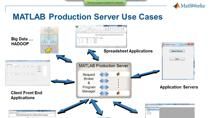Connect MATLAB to AVEVA PI System
Develop MATLAB® functions with OSIsoft® PI Asset Framework data and deploy to production to explore trends, uncover insights, and predict events using free add-on products. The MATLAB interface for OSIsoft PI System™ enables you to analyze your OSIsoft PI System data using your own algorithms that can leverage MATLAB and dozens of add-on products. You can:
- Visualize the findings
- Create reports and share your insights
- Flag anomalies
- Identify preventative maintenance patterns
- Predict remaining useful life of assets
Requirements for the MATLAB interface for OSIsoft PI System:
- MATLAB (R2022a or later): included in Industrial Communication Toolbox
- MATLAB (R2018a-R2021b): installs as a MATLAB toolbox add-on
- PI Server (2018 SP2 or later)
- PI Asset Framework (2018 2.10.x or later)
- PI Asset Framework SDK
- PI System Access License
The MATLAB Production Server® interface for OSIsoft PI System enables you to use MATLAB functions as part of your production workflow. You can map OSIsoft PI AF asset data as MATLAB function arguments and perform live data analysis. You can also write back analysis results to OSIsoft PI AF and use them in your reports and OSIsoft tools like PI Vision. Additional capabilities let you:
- Automate algorithm execution with production data from OSIsoft PI AF
- Run multiple analyses at scale with MATLAB Production Server
- Write results back to OSIsoft PI AF or other downstream systems, adding deep insight to process monitoring
- Display results with OSIsoft user interface tools
Requirements for the MATLAB Production Server interface for OSIsoft PI System:
- MATLAB (R2018 and later): installs as a downloadable support package
- MATLAB Compiler (R2018a or later)
- MATLAB Compiler SDK (R2018a or later)
- MATLAB Production Server (R2018a or later)
- PI Server (2018 SP2 or later)
- PI Asset Framework (2018 2.10.x or later)
- PI Asset Framework SDK
- PI System Access License
Published: 29 Jul 2021





